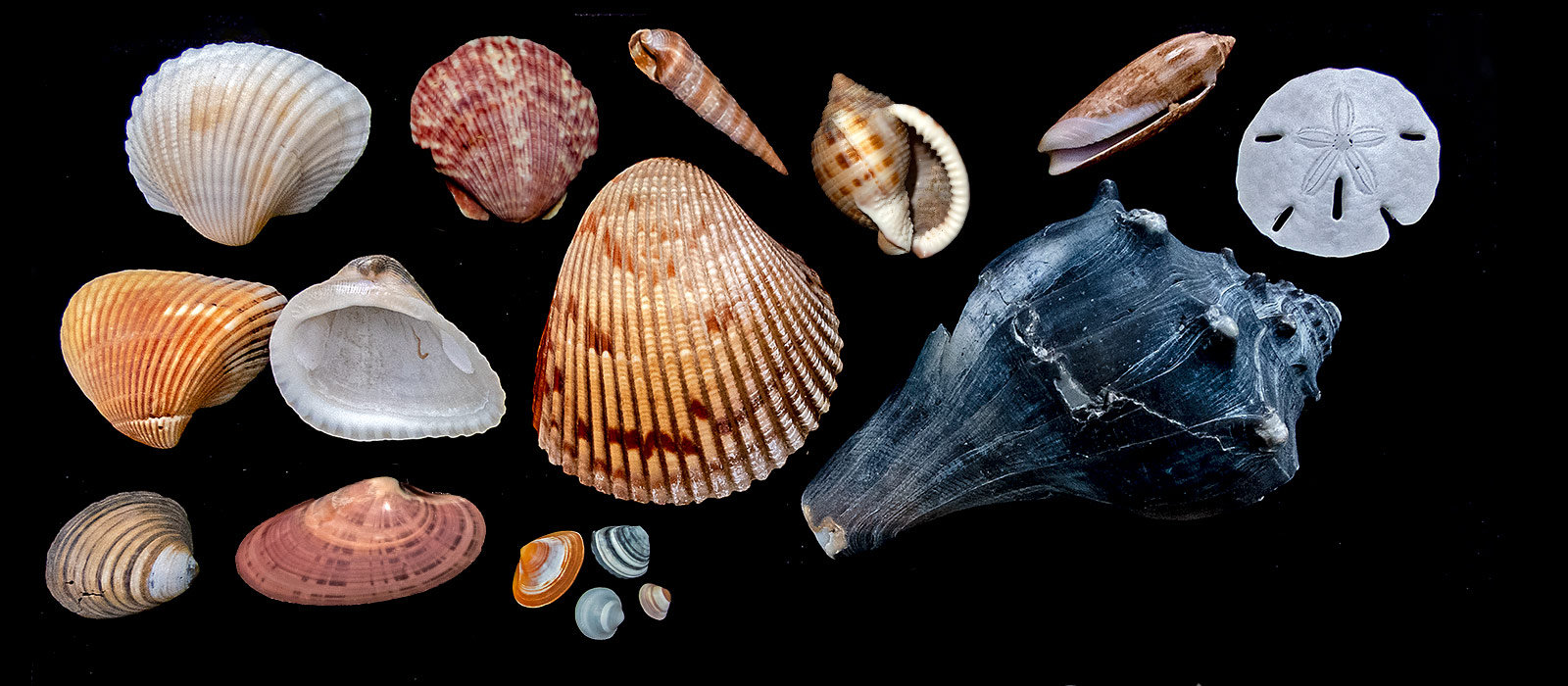
The Poetry of Seashells
10 Reasons to Take up Beachcombing (Especially You Birdwatchers)
“If there is poetry in my book about the sea, it is not because I deliberately put it there, but because no one could write truthfully about the sea and leave out the poetry.”
Rachel Carson,
upon receiving the National Book Award in 1952 for The Sea Around Us
Before all that she gave us in Silent Spring, before the hardship she endured after its publication, including cancer and attacks by the chemical industry, and before she proved that one person can indeed change the world, Rachel Carson gave us the sea.
Covering 70 percent of the planet, the seas offer incomprehensible diversity that most of us will never know. I confess to such ignorance. When terrestrial types like me find ourselves on a beach, it is often to comb the place for sandpipers migrating, Northern Gannets plunge-diving, ducks courting or other birds working the surf.
And yet there at our feet (or beneath our boots) are envoys of the deep: the calcium carbonate palaces from some of the most ornate creatures on earth. Most of us will never visit with these animals to learn of their habits and idiosyncrasies far beneath. But fear not: The tides and the waves cast ashore their lovely remains. All we need is to stop and look — and imagine.
At long last I’ve become a beachcomber. From my temporary outpost here in North Carolina, beside a preserve that bears her name, I have discovered joy and wonder in these poets from Rachel Carson’s prose. So here are some images and 10 lessons I have already learned so that perhaps you (especially you birders) might find poetry at the shoreline.
- Seashells don’t fly away. It’s great: You just walk over and pick ’em up.
- When you find seashells you are probably … you know … walking around on a beach by the sea.
- Walking around is good for the soul. On beaches you and your mind tend to wander and relax — even as you’re looking for shells. It’s like meditating in a nice place, focusing on what’s there in front of you — and not what’s next. (This is particularly useful for birders.)
- You need no expensive binoculars. You don’t need binoculars at all. Just your eyes, your hands and your senses, including a sense of adventure and possibility.
- Because they don’t fly away, and because you can pick them up, you can hold a seashell next to the picture in your field guide. (I’m using actual books — not apps.) You cannot do that with birds — at least not legally or without a permit or without possibly harming birds.
-
When you look for seashells, you sometimes find nice birds, like this Red Knot here, feeding at the Rachel Carson Reserve here in Beaufort, North Carolina.
- Seashells are easy to photograph. I took 245 photos of that Red Knot (I kid you knot) and kept only nine of them. I easily photographed the shells on display in this blog post while they rested on my black laptop computer case, and then worked them over a bit in PhotoShop. (I did it all with a point-and-shoot. You can too.)
- Even novices (like me) can find exciting things. Scotch Bonnet (Semicassis granulata), the North Carolina state seashell, is a prize down here. I found one! It’s a bit like finding a Spruce Grouse or a King Rail. Yeah, they’re around, hard to see, and a thrill every time.
- Humility. I’m reluctant to mention humility because it is a worn-out theme in nature writing. Yet one of the most common shells out here — Atlantic Giant Cockle — was a complete mystery to me when I arrived. As I combed the pages of my field guides, with a few of these shells in hand, I was like a new birder with not a clue as to the identity of a Song Sparrow. And then, when I landed on this bivalve in the guide, with all its proper field marks, I called out in joy its scientific name: Dinocardium robustum. I said it many times. Dinocardium robustum translates roughly into big, big heart. I’m good with that.
- Finally, these things are friggin’ beautiful! So here below are my images of a few more. Click any one for a bigger view and the option to start a slide show. (By the way, please send me any corrections to my IDs. Thanks!)
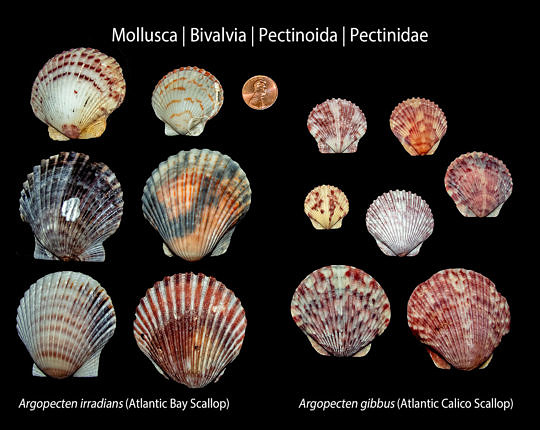
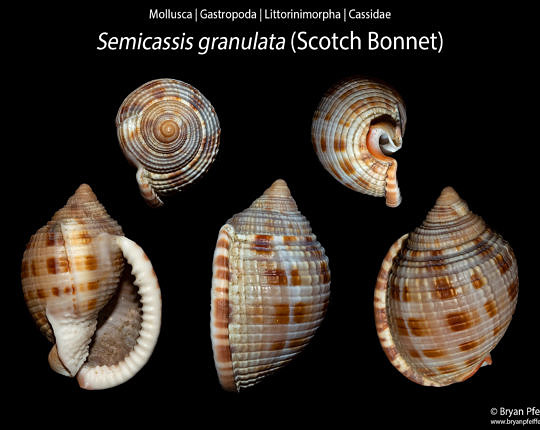

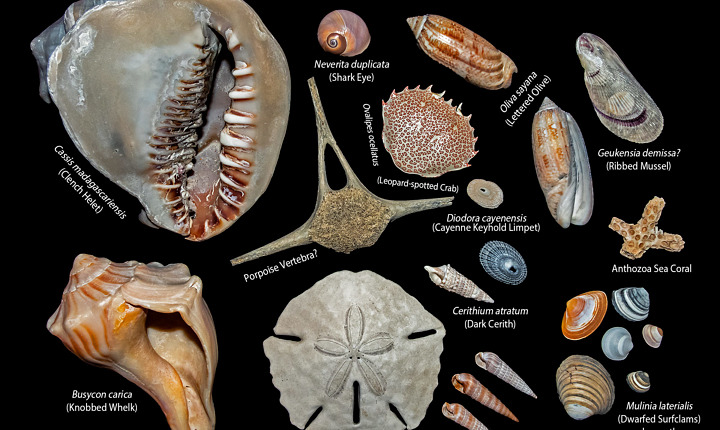


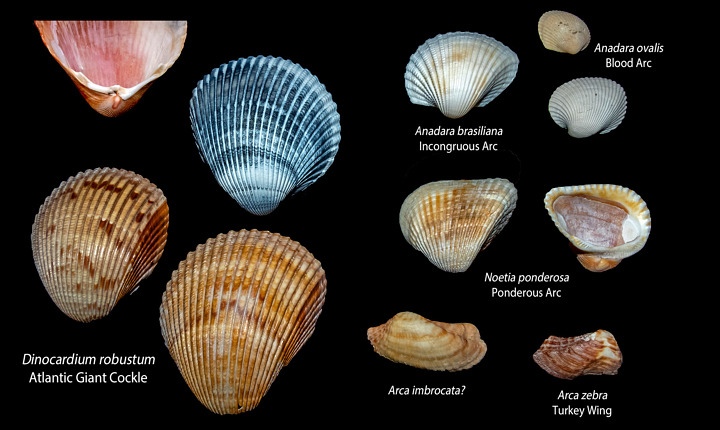

do you know how to find the seashells that you are looking for
Bryan- you are truly a man of many talents and interests! So grateful our paths crossed recently. When I was working, I used R. Tucker Abbot -North American Seashells – 1974, to ID mollusks from NE to FL. Most of my samples were from New England, but we did have some projects further south and they were always a treat to see as the species were often very different.
In your wonderful photos, off the top of my head, I would question your Mulinia lateralis group. The larger brown striped/ridged one may be an Astarte species, and the others in that grouping include a few other genera.
I’m so impressed you’re teaching yourself yet another Phylum! I’m excited to have learned just 4 new birds out here! They don’t sit still long enough like the mollusk shells do!
Thanks for reading, Mike!
Thanks, Will. Yeah, what’s next? Good question. In spite of our assault on the world and its biological diversity, ironically there will indeed be a “what’s next.” Nature is like that.
Thank you for these articles,I appreciate them.
So cool – thank you, Brian! I love your ability to pivot – from birds to dragonflies and other insects and now to shells. What’s next? The world is so diverse it might take a lifetime!
A great day indeed, Stan. Thanks for being part of it — and for the carvings tour!
It is a joy to see words recreate memory of a great day on the Cape Lookout shore
Thanks
Beautiful writing and thoughts, Bryan.
Thank you!
I’m really starting to get these — how to look for them and how to look at them. It’s knowledge and awareness — our very nature.
Thanks so much for sharing this, Craig. It’s so reflective of the healing qualities of nature, wherever we may discover and enjoy it. Walking is precious, especially on beaches. In fact, I think I’ll go read Thoreau’s “Walking” — yet more inspiration. Thanks again!
Oh, my. I’m speechless. I don’t believe anyone has ever written a poem about me. I am beyond grateful — and humbled. Thanks so much, Bernie. This is lovely. It means a lot to me. Wow.
I myself have found patches of certain species. So I suspect there’s some validity to this, Mary Jo. But I’m so new to molluscs that I honestly don’t know the answer to your question. I’ll try to find out!
Inspiring post. I wonder if at some point, you can comment on an observation I made on the Beach in Naples, FL years ago (perhaps on more than one occasion). I was searching for a certain shell which looked like a mini conch shell, and found that it occurred in patches as I walked along. It made me wonder if there are “beds” or colonies of them off shore. Do these organisms occur in certain places and not in others for reasons of habitat, food availability, proximity of mates, defense, etc. ? Before seeing that pattern, I assumed that the organisms were evenly distributed along the beach and in the water.
Seashells by the sea shore
Well actually, they are on the shore as much as by the shore
Bryan, with Rachel Carson guiding his instinct
tree paper guide books guiding his inquisitiveness
water and sand pulling at his feet.
Pfeiffer gave us
birds that fly, birds that sing,
butterflies and Joy, dragonflies and sex,
precious moments,
a precious unclaimed hour (in nature),
snows of Autumn, (Snow Goose, Snowy Owl),
the incredible adventures of migration,
the agony of extinctions
the discovery of what lives with us at our elbows (BioBlitz).
And now again he cradles nature
not with a net, or binoculars, or waders;
-with bare feet, rolled up pant legs,
as he stops, looks, and imagines
what the ‘calcium carbonate palaces’
washed ashore in passive timeless
beachcomber fashion
tell us
about themselves and the sea.
Once again, Bryan reminds us
nature is all about ‘right now’-
“focusing on what’s there in front of you”.
Seashells by the seashore
Giant Cockles
Dinocardium robustum
Big heart indeed
Place that big Conch shell to your ear
Can you hear it beating away?
Bryan Pfeiffer has a big heart indeed.
~Bernie
I moved to the USVI when I was just turning sixteen, from Montpelier and by myself to escape a home fraught with domestic violence. I lived there, for nearly a year. Working and spending every free second walking the beaches of the 5 closest islands until my soul had been healed. The waters warmth was like a hug and the waves were the wisdom filled whispers I needed to get through that part of my life.
Good luck chance friend! I hope the beaches are as kind to you as they have been to me.
“When I pass bring me back to the sea, where I once was and always wish to be” – Craig McDermott, Montpelier. VT.
I visited Sanibel, last February. Didn’t find as many shells as I expected, but still a lot of fun! I recognize several of the ones you photograghed.
Yes, there is some concern about collecting. Here’s an example. It’s something I’ll write about in the future. I’m not collecting. in fact many of the shells in those photos of mine have been — or will be — returned to the surf. I have no desire to put together a large collection. Just a few keepsakes. And I do think it responsible to enter findings in iNaturalist or other crowd-sourced biodiversity portals. In any event, I’ll explore more this collecting thing — practically, culturally and ethically. One other concern is loss of hiding spots for hermit crabs, small fish and other wildlife that use shells for resting or defense. Overall, I suspect it can be a localized problem. Commercialized collecting, I suspect, would be a big problem. But collecting can also spark outsized debates, which is the case in entomology, where the harm can occasionally be real, but is more often over-stated. But thanks so much for asking. I’ll do some research! This Smithsonian article also seems pretty good.
This is lovely, Sharon. So many comments from or about Sanibel. (We ought to convene a meeting there! 🙂 ) The other day, as I explored a spot with a mystery bivalve buried in the wet sand, I poked at it a bit and had a nice geyser erupt at me a few times. It turned out to be a Dinocardium robustum — shaped like a big heart, which I dutifully placed back in the surf.
I found a couple more Turkey Wings yesterday — I’m really liking that family: Arcidae. Can’t say why yet.
Hi Sandra. Nice to hear from you! It’s been incredible reading all these comments about shells and memories. (I was indeed alive when Silent Spring was published. 🙂 But not by much. I’m glad to hear you’re still getting out — just not now, though, during the Polar Vortex right?
Wonderful..I have collected shells all my life, starting with clamshells on the beaches of Massachusetts, ending with “cuernos” here in Mexican beaches: ending because I have understood that it is no longer a good thing (or even legal) to collect shells in many places..true????
Thanks so much, Bryan. I’m heading to Sanibel next month with my point and shoot (ahh…a black background…so much clearer than sand…I may need to experiment), happy to walk for hours each morning to discover what magic has come ashore overnight. I, too, love the Scotch Bonnet (and the nutmeg). While in Sanibel, the search is always on for the elusive Junonia (great glories bestowed on those who find one). But any beautiful find may now just make me want to break out, whether appropriate or not, with “Dinocardium Robustum!”
Turkey wings! My favorite. Oh, wait. Lettered olive. Or sunray venus…. Another Sanibel stooper who loves watching the little coquinas rebury themselves before the “Long Legs” get them.
Hi Bryan, Hate to admit this but I bought and read Silent Spring before I was married in 1956, while still living in Brooklyn with my parents. It was a wonderful book. Were you born then? I have learned so much since I started birding with Ted Allen, then you, then the Mad Birders. Still love getting outdoors whenever I can.
Oh, I forgot — I gotta go listen! That helmet shell should be noisy!
Thanks, Barbara! Not bad shots from a point-and-shoot! 🙂
Thanks, Louise. And Terry can explain the geology related to your shells, right? 🙂
Nice to hear from you, Anne. Lots of folks writing in from Sanibel. Enjoy!
Yes, Ann — and it’s so nice that they don’t fly away when you’re learning them! 🙂
And it helps build strong bodies 12 ways, right? (Wrong!) Thanks, Erica!
This is wonderful. Thanks, Andy. Yes, I think any link like this to childhood experience has lots of meaning and, of course, can be indelible. (I do like to think of myself as a 60-year-old 15 year old. 🙂
Thanks, Maryella. I’m just back from a walk — with more arcs and a new cockle!
Hi Terry, Your mom got a great deal! Especially for that blue sea glass. I’ve also collected a bit of sea glass, with the same joy I now have with these shells. Thanks for sharing. This is great.
We collected shells on Long Island Sound as a kid. My mother would send us out to gather shells and sea glass(1 cent for plain, 2 cents for blue) which would keep us busy for hours. Later at home she would have us make art with all the shells/glass that we had collected. She was able to read many novels and enjoy the art work we created!
Beautiful they are in deed. And very interesting also. Thanks so much.
I was a shell collector as a child. I picked up on it again when my children were little and we vacationed on the west coast of Florida – on Sanibel Island or Captiva. As I see it, there are few activities in life that are more rewarding and good for the soul. I still love collecting shells on those occasions when I am vacationing near a beach and I am then taken back to my childhood, full of awe and excitement and truly believe that those moments are among the most fulfilling in my life and to those who also share this passion.
Pro tip for getting the shells home intact, learned from my host in Sanibel: pack in slices of white bread. It’s the only time in my adult life that I’ve bought a loaf of white bread, and it works. I got home from Sanibel with a stiff neck from doing the Sanibel Stoop and not a single broken shell.
Glad you caught the sea-shell bug! Have collected and tried to ID shells on all the beaches I’ve encountered since about 1973. It’s as addictive as birds (or dragonflies).
Reading this between beach walks on Sanibel! I too have the enthusiasm of a novice.
I love your sea shells. Have collected since I was a child, Galveston, Wrighteville Beach, Florida. Still have many of the best of my collection.
Thank you, as always, for spotlighting beauty, Bryan! Wonderful!
Gorgeous photos. I can almost hear the roar of the ocean by just looking at them.
Sensitive and full of love for nature and its lessons. Thanks Bryan.